Delft
Delft | |
|---|---|
City and municipality | |
 Aerial view of Delft with, from left to right, three churches, a university tower building and a windmill | |
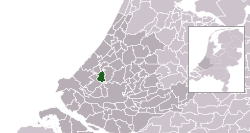 Location in South Holland | |
| Coordinates: 52°0′42.25″N 4°21′33.15″E / 52.0117361°N 4.3592083°E | |
| Country | Netherlands |
| Province | South Holland |
| Government | |
| • Body | Municipal council |
| • Mayor | Marja van Bijsterveldt (CDA) |
| Area | |
| • Total | 24.06 km2 (9.29 sq mi) |
| • Land | 22.65 km2 (8.75 sq mi) |
| • Water | 1.41 km2 (0.54 sq mi) |
| Elevation | 0 m (0 ft) |
| Population (January 2021)[4] | |
| • Total | 103,581 |
| • Density | 4,573/km2 (11,840/sq mi) |
| Demonym | Delftenaar |
| Time zone | UTC+1 (CET) |
| • Summer (DST) | UTC+2 (CEST) |
| Postcode | 2600–2629 |
| Area code | 015 |
| Website | www |
Delft ([dɛlft] ⓘ) is a city and municipality in the European country of the Netherlands. There it is located in the province of South Holland.
Delft is a town with medieval roots and among other things because in its historical town centre with canals and antique bridges many monumental buildings are visible, the place is a world known tourist attraction.
As a result of the fact that Delft hosts a renown university of technology ("TU Delft"), it also is a widely known student city. The presence of several related technical institutions and companies results in its status as a centre of technical industry.
Another main branche of industry in this town is the world-famous artistic Delft Blue pottery.
One of the most famous scientists that originated from and worked in Delft is Antony van Leeuwenhoek, known as "the Father of Microbiology".
Famous jurist and author Hugo Grotius, who is considered as the founder of international law equally originated from Delft.
In the field of art Delft is known as the birth place of seventeenth-century Dutch Master painter Johannes Vermeer.
Historically this town is closely connected to the royal House of Orange-Nassau.
Nearby bigger towns are Rotterdam in the south and The Hague in the north.
History
Early history
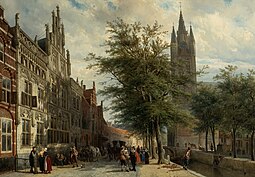

The city of Delft came into being beside a canal, the 'Delf', which comes from the word delven, meaning delving or digging, and led to the name Delft. It presumably started around the 11th century as a landlord court.
From a rural village in the early Middle Ages, Delft developed into a city, that in the 13th century (1246) received its charter. (For some more information about the early development, see Gracht).
The town's association with the House of Orange started when William of Orange (Willem van Oranje), nicknamed William the Silent (Willem de Zwijger), took up residence in 1572. At the time he was the leader of growing national Dutch resistance against Spanish occupation, known as the Eighty Years' War. By then Delft was one of the leading cities of Holland and it was equipped with the necessary city walls to serve as a headquarters. An attack by Spanish forces in October of that year was repelled.
After the Act of Abjuration was proclaimed in 1581, Delft became the de facto capital of the newly independent Netherlands, as the seat of the Prince of Orange.
When William was shot dead in 1584 by Balthazar Gerards in the hall of the Prinsenhof, the family's traditional burial place in Breda was still in the hands of the Spanish. Therefore, he was buried in the Delft Nieuwe Kerk (New Church), starting a tradition for the House of Orange that has continued to the present day.
Delft Explosion
The Delft Explosion, also known in history as the Delft Thunderclap, occurred on 12 October 1654 when a gunpowder store exploded, destroying much of the city. Over a hundred people were killed and thousands were wounded.

About 30 tonnes (29.5 long tons; 33.1 short tons) of gunpowder were stored in barrels in a magazine in a former Clarissen convent in the Doelenkwartier district. Cornelis Soetens, the keeper of the magazine, opened the store to check a sample of the powder and a huge explosion followed. Luckily, many citizens were away, visiting a market in Schiedam or a fair in The Hague.
Today, the explosion is remembered primarily for killing Rembrandt's most promising pupil, Carel Fabritius, and destroying almost all his works; a pivotal event in Donna Tartt's Pulitzer Prize-winning 2013 novel The Goldfinch.
Delft artist Egbert van der Poel painted several pictures of Delft showing the devastation.
Sights
The city centre retains a large number of monumental buildings, while in many streets there are canals of which the banks are connected by typical bridges,[5] altogether making this city a notable tourist destination.[6]
Historical buildings and other sights of interest include:
- Oude Kerk (Old Church). Buried here: Piet Hein, Johannes Vermeer, Anthony van Leeuwenhoek.
- Nieuwe Kerk (New Church), constructed between 1381 and 1496. It contains the Dutch royal family's burial vault which, between funerals, is sealed with a 5,000 kg (11,023 lb) cover stone.
- A statue of Hugo Grotius created by Franciscus Leonardus Stracké in 1886, located on the Markt near the Nieuwe Kerk.
- The Prinsenhof (Princes' Court), now a museum.[6]
- City Hall on the Markt.
- The Oostpoort (Eastern gate), built around 1400. This is the only remaining gate of the old city walls.
- The Gemeenlandshuis Delfland, or Huyterhuis, built in 1505, which has housed the Delfland regional water authority since 1645.
- The Vermeer Centre in the re-built Guild house of St. Luke.
- The historical "Waag" building (Weigh house).
- Windmill De Roos, a tower mill built c.1760. Restored to working order in 2013.[7] Another windmill that formerly stood in Delft, Het Fortuyn, was dismantled in 1917 and re-erected at the Netherlands Open Air Museum, Arnhem, Gelderland in 1920.
 |
 |
 |
Culture

Delft is well known for the Delft pottery ceramic products[6] which were styled on the imported Chinese porcelain of the 17th century. The city had an early start in this area since it was a home port of the Dutch East India Company. It can still be seen at the pottery factories De Koninklijke Porceleyne Fles (or Royal Delft) and De Delftse Pauw.
The painter Johannes Vermeer (1632–1675) was born in Delft. Vermeer used Delft streets and home interiors as the subject or background in his paintings.[6] Several other famous painters lived and worked in Delft at that time, such as Pieter de Hoogh, Carel Fabritius, Nicolaes Maes, Gerard Houckgeest and Hendrick Cornelisz. van Vliet. They were all members of the Delft School. The Delft School is known for its images of domestic life, views of households, church interiors, courtyards, squares and the streets of Delft. The painters also produced pictures showing historic events, flowers, portraits for patrons and the court as well as decorative pieces of art. Delft supports creative arts companies. From 2001 the Bacinol, a building that had been disused since 1951, began to house small companies in the creative arts sector. However, demolition of the building started in December 2009, making way for the construction of the new railway tunnel in Delft. The occupants of the building, as well as the name 'Bacinol', moved to another building in the city. The name Bacinol relates to Dutch penicillin research during WWII.
Education
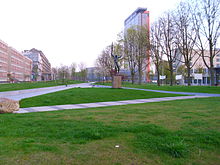
Delft University of Technology (TU Delft) is one of four universities of technology in the Netherlands.[8] It was founded as an academy for civil engineering in 1842 by King William II. Today just under 20,000 students are enrolled.[9]
The UNESCO-IHE Institute for Water Education, providing postgraduate education for people from developing countries, draws on the strong tradition in water management and hydraulic engineering of the Delft university.
Economy
In the local economic field essential elements are:
- education; (a.o. Delft University of Technology) (As of 2007[update] 14.299 students, 2.712 scientists and 1.859 researchers),
- scientific research; (a.o. "TNO" Netherlands Organisation for Applied Scientific Research), Stichting Deltares, Nederlands Normalisatie-Instituut, UNESCO-IHE Institute for water education.
- tourism; (about one million registered visitors a year),
- industry; (DSM Gist Services BV, (Delftware) earthenware production by De Koninklijke Porceleyne Fles, Exact Software Nederland BV, TOPdesk, Ampelmann)
- retail; (IKEA ( Inter IKEA Systems B.V., owner and worldwide franchisor of the IKEA Concept, is based in Delft), Makro, Eneco Energy NV).
Nature and recreation
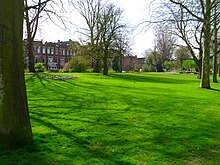
East of Delft lies a relatively vast nature and recreation area called the "Delftse Hout" ("Delft Wood")[10] is situated. Through the forest lie bike, horse-riding and footpaths. It also includes a vast lake (suitable for swimming and windsurfing), narrow beaches, a restaurant, community gardens, plus camping ground and other recreational and sports facilities. (There is also a facility for renting bikes from the station.)
Inside the city, apart from a central park, there are also several smaller town parks, like "Nieuwe Plantage", "Agnetapark", "Kalverbos" and others. Furthermore, there is the Botanical Garden of the TU and an arboretum in Delftse Hout.
Famous people from Delft
Delft was the birthplace of:
Before 1900
- Michiel Jansz. van Mierevelt (1567–1641), painter
- Willem van der Vliet (c. 1584–1642), painter
- Hugo Grotius (1583–1645), lawyer who laid the foundations for international law
- Adriaen van de Venne (1589–1662), painter
- Daniël Mijtens (c. 1590–1647/48), painter
- Leonaert Bramer (1596–1674), painter
- Martin van den Hove (1605–1639), astronomer and mathematician
- Hendrick Cornelisz. van Vliet (1611 or 1612–1675), painter
- Daniel Vosmaer (1622-1666), painter
- Willem van Aelst (1627–1683), painter
- Antonie van Leeuwenhoek (1632–1723), father of microbiology and developer of the microscope
- Johannes Vermeer (1632–1675), painter
After 1900
- Vincent de Moor (1973), producer, remixer (Trance)
- Stien Kaiser (1938), former speed skater
- Michaëlla Krajicek (1989), professional tennis player
- Atzo Nicolaï (1960), politician
- Alexander Pechtold (1965), politician
- Betsy Perk (1833-1906), novelist, playwright
- Arantxa Rus (1990), professional tennis player
- Ria Stalman (1951), former discus thrower and shot putter
- Hans Galjé (1957), former footballer
- Roel van Velzen (1978), singer
Otherwise related
- Kader Abdolah (1954), writer
- Martinus Beijerinck (1851–1931), microbiologist and discoverer of viruses, lived and worked in Delft
- Ferrie Bodde (1982), football player
- Ken Monkou (1964), football player
- Jan Timman (1951), chess grandmaster, raised in Delft
Miscellaneous

- Nuna is a series of manned solar-powered vehicles, built by students at the Delft University of Technology, that won the World solar challenge in Australia seven times in the last nine competitions (in 2001, 2003, 2005, 2007, 2013, 2015 and 2017).[11]
- The so-called "Superbus" project aims to develop high-speed coaches capable of speeds of up to 250 kilometres per hour (155 mph) together with the supporting infrastructure including special highway lanes constructed separately next to the nation's highways; this project was led by Dutch astronaut professor Wubbo Ockels of the Delft University of Technology.
- Members of both Delft Student Rowing Clubs Proteus-Eretes and Laga have won many international trophies, including Olympic medals, in the past.[12]
- The Human Power Team Delft & Amsterdam, a team consisting mainly of students from the Delft University of Technology, has won The World Human Powered Speed Challenge (WHPSC) four times. This is an international contest for recumbents in the US state of Nevada, the aim of which is to break speed records [13]. They set the world record of 133.78 kliometres an hour (83.13 mph) in 2013.
International relations
Twin towns — Sister cities
|
|
|
Transport

- Delft railway station; (in February 2015 a new station has been taken into use).[16]
- Delft Zuid railway station
Trains stopping at these stations connect Delft with, among others, the nearby cities of Rotterdam and The Hague, up to every five minutes, for most of the day.
There are several bus routes from Delft to similar destinations. Trams frequently travel between Delft and The Hague via special double tracks crossing the city. One of those two lines (19) is still under construction inside Delft and is meant to connect The Hague with a science park, which is being developed on the southern (Rotterdam) side of Delft and is a joint project by the Delft and Rotterdam municipalities.[17]
See also
Galery
 |
 |
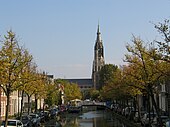 |
 |
 |
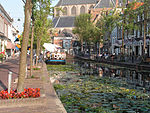 |
 |
 |
Notes
- ^ "Maak kennis met..." [Meet...]. Burgermeester Verkerk (in Dutch). Gemeente Delft. Archived from the original on 18 July 2013. Retrieved 18 July 2013.
{{cite web}}: Unknown parameter|dead-url=ignored (|url-status=suggested) (help) - ^ "Kerncijfers wijken en buurten 2020" [Key figures for neighbourhoods 2020]. StatLine (in Dutch). CBS. 24 July 2020. Retrieved 19 September 2020.
- ^ "Postcodetool for 2611GX". Actueel Hoogtebestand Nederland (in Dutch). Het Waterschapshuis. Retrieved 18 July 2013.
- ^ "Bevolkingsontwikkeling; regio per maand" [Population growth; regions per month]. CBS Statline (in Dutch). CBS. 1 January 2021. Retrieved 2 January 2022.
- ^ Bridges in Delft
- ^ a b c d Martin Dunford (2010). The Rough Guide to The Netherlands. Penguin. p. 169. ISBN 978-1-84836-882-8. Retrieved 24 November 2011.
- ^ "Delft, Zuid-Holland" (in Dutch). Molendatabase. Retrieved 22 October 2014.
- ^ https://www.4tu.nl/en/
- ^ http://www.tudelft.nl/fileadmin/Files/tudelft/over/Feiten_en_cijfers/jaarverslagen/facts___figures_2015_digi.pdf
- ^ "Category:Delftse Hout". Retrieved 6 May 2015.
- ^ www.worldsolarchallenge.org
- ^ List of trophies won by Proteus-Eretes members
- ^ website of the WHPSC
- ^ (source: Delft municipality guide 2005)
- ^ "List of Twin Towns in the Ruhr District" (PDF). © 2009 Twins2010.com. Archived from the original (PDF) on 2009-11-28. Retrieved 2009-10-28.
{{cite web}}: External link in|publisher=|deadurl=ignored (|url-status=suggested) (help) - ^ "Category:Spoorzone-project". Retrieved 6 May 2015.
- ^ "Nieuwe tram -en buslijnen" [New tram and bus lines]. Traffic and Transit (in Dutch). Haaglanden Urban Regio. Archived from the original on 22 May 2013. Retrieved 16 March 2013.
{{cite web}}: Unknown parameter|deadurl=ignored (|url-status=suggested) (help)
References
- Lourens, Piet; Lucassen, Jan (1997). Inwonertallen van Nederlandse steden ca. 1300–1800. Amsterdam: NEHA. ISBN 9057420082.
{{cite book}}: Invalid|ref=harv(help)
Further reading
- See also: Bibliography of the history of Delft
- Vermeer: A View of Delft, Anthony Bailey, Henry Holt & Company, 2001, ISBN 0-8050-6718-3



